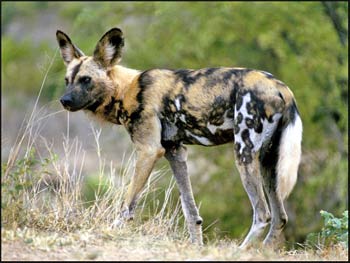Hippos may look cute but don't be taken in by that appearance. They are still the animal to cause the most human deaths in Africa. They can cut a crocodile or a canoe in half with those massive jaws and teeth.
African wildlife pictures are a great way to remind yourself of your safari experience and to show others exactly what you saw.
And it's a lot of fun to capture images of Africa animals as they go about their daily lives in the wild, but it's not always easy because a safari places some specialized demands on a photographer.
I have been taking wildlife photos on safari in Southern Africa for over twenty five years now and I still enjoy it immensely. It is true that some game reserves and national parks in Africa are better for taking wildlife pictures than others and some safari operators are more specialized than others (these are the top photographic safari operators in Africa).
A lot depends on luck of course, because a safari is not like a visit to your local zoo, so there is no guarantee of what you will see. The longer you spend on safari, the luckier you tend to get because the probability of spotting animals increases the more time you spend driving around looking for them. I recommend spending a minimum of seven days on safari to get a broad range of wildlife pictures, with two weeks being ideal.
Some areas in Africa have a higher concentration of certain animals or less vegetation which makes visibility better and therefore your wildlife images chances improve, so it's important to choose the right destination.
And the times that you go on safari can also be critical such as for the wildebeest migration in Eastern Africa which only takes place at certain times of the year, depandant on when the rains fall. And in some areas winter is a better time to go because there is no rain so the vegetation becomes less dense and the animals congregate around the waterholes making them easier to find and photograph.

A safari isn't just about the bigger animals. It's worth stopping to get a closer look at this unique character. They have the amazing ability to change their colour to match the surroundings. The chameleon photo here was taken in Madagascar.

This is the most successful predator in Africa with the vast majority of their hunts ending successfully because they work very efficiently as a team. Unfortunately their numbers are decreasing rapidly in Africa.

Competition between hyena and the other predators for food is intense. They will even chase lions away from their own kill if there are enough of them around and two of them are enough to intimidate a cheetah.

Due to the value of its horn on the black market which caused severe poaching, the black rhinoceros has been teetering on the brink of extinction for awhile. There are only an estimated 3000 of them left in the world so wildlife pictures of them are rare.

This rhinoceros wasn't named after the colour of its hide even though it might seem lighter than its smaller counterpart. The name comes from the Afrikaans term wyd meaning wide because of the width of it's lower lip.

The tallest African animal could also easily qualify as the most inquisitive. They serve as excellent predator wildlife pictures indicators because they will all stare intently at the spot where a lion, hyena or leopard is situated.

They can cling to almost any surface in a way that would make spider man proud and they do it by means of densely packed hairs on their footpads. Geckos are also unique amongst the lizards in the vocalizations they make to communicate.

I spotted this lizard at one of the rest camps in the Kruger National Park in South Africa. It's amazing how well it matches the tree bark that it was clinging to in an attempt to escape detection. But I would not be denied and snapped this photo before he scuttled up into the higher branches and out of reach of my lens.

The striped horses of the African savannah can be found in almost all of the game reserves there. They congregate in large herds alongside other herbivores like impala and wildebeest for added protection against the predators and make great subjects for close-up wildlife pictures.


